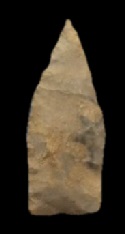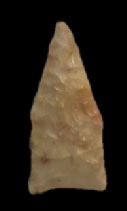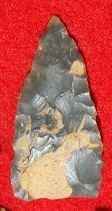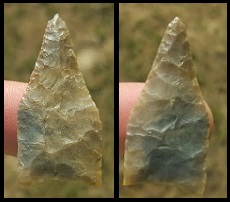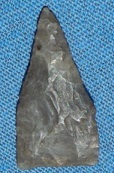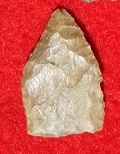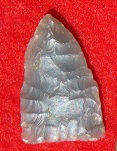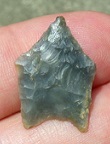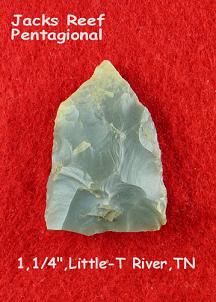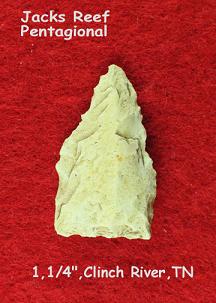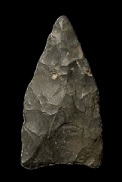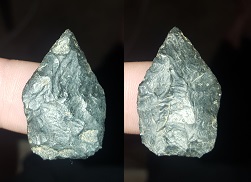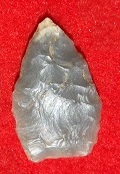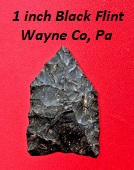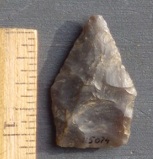Outline is Representative of Size and Shape: 
Name Details:
Identified By: William A. Richie
Named For: Type Site
Date Identified: 1961
Type Site: Jacks Reef Site, Onondaga County, New York
Identified By: William A. Richie
Named For: Type Site
Date Identified: 1961
Type Site: Jacks Reef Site, Onondaga County, New York
Point Validity:
Valid type
Richie was a prominent anthropologist who served as the state archaeologist for the State of New York, the State Museum and Science Service. He excavated over 100 sites in the state of New York and published over 150 professional publications. He named this type in a professional publication and this type has many professional references. This is considered a valid type.
Richie was a prominent anthropologist who served as the state archaeologist for the State of New York, the State Museum and Science Service. He excavated over 100 sites in the state of New York and published over 150 professional publications. He named this type in a professional publication and this type has many professional references. This is considered a valid type.
Jacks Reef Pentagonal
Cluster: Mississippian Pentagonal Cluster Description of Physical Characteristics and Flaking Pattern:
This is a thin small to medium (.5 to .75 inches) pentagonal point with a flattened cross section. The blade may vary from straight to excurvate from the point to the hafting region. The hafting area may vary from straight to contracting giving the point a pentagonal shape. The blade may vary from symmetrical to asymmetrical. The base is most commonly straight, but some examples have had concave bases. This point has a random flaking pattern.
Size Measurements:
Total Length - 25 to 61 mm (42 mm average), Length of Hafting Area - 12 to 28 mm (20 mm average), Width - 24 to 21 mm (23 mm average), Thickness - 3 to 8 mm
Total Length - 25 to 61 mm (42 mm average), Length of Hafting Area - 12 to 28 mm (20 mm average), Width - 24 to 21 mm (23 mm average), Thickness - 3 to 8 mm
Commonly Utilized Material:
Additional Comments:
The Jack's Reef Pentagonal and the Pee Dee are thought to represent the same point. This point is called Jack's Reef Pentagonal in the Northeast and into the Ohio and Tennessee river basin's. It is called Pee-Dee in Virginia and into the Carolina's (W10). This point has been called the Mississippi Pentagonal point (Cambron, 1975).
This point is similar in form to the Jack's Reef Corner Notch, but lacks the hafting element. This point has been thought to be a preform for the Jack's Reef Corner Notch, but these points also served as finished tools and points (Justice, 1987).
Lowe (2013) suggest that these points originated on the Atlantic Coast and then spread westward.
The Jack's Reef Pentagonal and the Pee Dee are thought to represent the same point. This point is called Jack's Reef Pentagonal in the Northeast and into the Ohio and Tennessee river basin's. It is called Pee-Dee in Virginia and into the Carolina's (W10). This point has been called the Mississippi Pentagonal point (Cambron, 1975).
This point is similar in form to the Jack's Reef Corner Notch, but lacks the hafting element. This point has been thought to be a preform for the Jack's Reef Corner Notch, but these points also served as finished tools and points (Justice, 1987).
Lowe (2013) suggest that these points originated on the Atlantic Coast and then spread westward.
Distribution: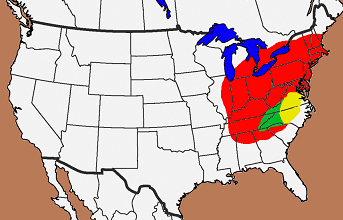

Distribution Comments:
This point is primarily found in the Northeast and into the Ohio River basin and Great Lakes region. This point may be found in other highlighted areas with decreasing frequency. Yellow distribution represents the distribution of the Pee Dee point. and the green is the distribution of the South Appalachian Pentagonal.
This point is primarily found in the Northeast and into the Ohio River basin and Great Lakes region. This point may be found in other highlighted areas with decreasing frequency. Yellow distribution represents the distribution of the Pee Dee point. and the green is the distribution of the South Appalachian Pentagonal.
Age / Periods:
Date: 1,500 - 1,000 B.P.
Cultural Period: Woodland
Glacial Period: Roman to Medieval Warm
Culture: Point Peninsula Culture
Date: 1,500 - 1,000 B.P.
Cultural Period: Woodland
Glacial Period: Roman to Medieval Warm
Culture: Point Peninsula Culture
Age Details:
This point is considered part of the Kipp Island / Hunter Home Phases.
This point is considered part of the Kipp Island / Hunter Home Phases.
Similar Points:
Caraway, Levanna, Madison, Mouse Creek, Pee Dee, South Appalachian Pentagonal, Susquehannock Triangle
Caraway, Levanna, Madison, Mouse Creek, Pee Dee, South Appalachian Pentagonal, Susquehannock Triangle
Other points in this cluster / Related / Associated Points:
Intrusive Mound, Jacks Reef Pentagonal, Knight Island, Raccoon Creek
Intrusive Mound, Jacks Reef Pentagonal, Knight Island, Raccoon Creek

